Why you can trust Tom's Hardware
All test results marked with "PBO" reflect configurations tested with AMD's auto-overclocking Precision Boost Overdrive feature. For overclocking, we tuned our memory to DDR4-3600 for most Intel and AMD platforms, but we used DDR4-3466 for the Ryzen 5 3400G, and DDR4-4000 in coupled mode for the Ryzen 7 Pro 4750G.
The TLDR


In the chart above, we plot gaming performance using average frame rates and a geometric mean of the 99th percentile frame times. Bear in mind that we tested with an Nvidia GeForce RTX 2080 Ti at 1920x1080 to alleviate graphics-imposed bottlenecks. Differences between our test subjects shrink at higher resolutions.
AMD certainly didn't design Renoir with a focus on complementing a discrete GPU - the idea here is to use the integrated RX Vega graphics for gaming. Of course, curious enthusiasts want to know if Renoir's monolithic die design imparts an advantage over standard Ryzen 3000 chips when paired with a discrete GPU.
The answer is no. The four-core eight-thread Ryzen 3 3300X comes with half the number of cores and threads as the 4750G, but its healthier dollop of 16MB of L3 cache outweighs the 4750G's 8MB, and that pays off when gaming with a discrete graphics card. The 4750G's relatively slim allotment of L3 cache definitely leads to less performance in latency-sensitive workloads. AMD is balancing its precious die area with the need for a large Vega graphics unit, which obviously requires some trade-offs. AMD probably chose to sacrifice some L3 cache capacity, and in light of the intended use case, the 8MB of capacity is probably right-sized for gaming with the iGPU.
The Ryzen 3 3300X doesn't have integrated graphics, but that helps keep pricing down for builds with a discrete GPU. You can find the 3300X for around $120, which makes it impossible to recommend the $309 4750G for gaming with a discrete graphics card.
Intel still holds its gaming performance crown, albeit by a small margin when compared to the Ryzen 3000 models, in this price bracket. In terms of average frame rates across the breadth of our test suite, the Core i7-10700F is 18.18% faster than the 4650G. The delta shrinks to 12% after tuning the Ryzen 7 Pro 4750G, but it's still significantly slower than the 10700. The less-expensive $263 Core i5-10600K is the go-to chip for gamers chasing the highest frame rates possible on a budget, and it lives up that billing in these tests, too. Just don't try to have a meaningful gaming experience on its lackluster integrated graphics.
The 4750G provides an impressive 28% increase in average frame rates over the Ryzen 5 3400G at stock settings, and a similarly impressive delta after overclocking. The extra cores, not to mention higher clock rates, provide a clear advantage over the previous-gen model.
Get Tom's Hardware's best news and in-depth reviews, straight to your inbox.
We'll skip commenting on the individual real-world game tests below because the results are fairly redundant, but they are there for your perusal. The overall takeaway is clear, but unsurprising: The Renoir chips are designed for gaming on integrated graphics, and that's what they excel at. They also put up a much better show in the application tests on the following page.
VRMark, 3DMark, Stockfish and Civilization VI on AMD Ryzen 7 Pro 4750G





Synthetic gaming benchmarks often aren't generally indicative of real-world performance, but the 3DMark DX11 and DX12 tests are interesting because they measure the amount of raw computational horsepower exposed to the game engine. For now, most of today's game engines don't scale as linearly with additional compute resources, but these tests help us gauge how games could exploit processing resources as the engines become more sophisticated.
As expected, the DX11 and DX12 tests put the threaded power of the 4750G's eight cores on full display as it puts on a convincing show in these very scalable workloads. We also see the same trend in the Stockfish AI engine, which is also designed extract the utmost in parallelism from multi-core designs. Renoir's extra threads pay off here as they deliver massive performance gains over the Ryzen 5 3400G, but the Core i7-10700F is within competitive range in these tests.
Performance isn't quite as great when we flip over to the workloads that prize per-core performance and/or lots of cache. VRMark and Civilization VI both prefer high clock rates and lots of L3 cache, pushing the Ryzen 7 Pro 4750G back down the rankings.
Ashes of the Singularity: Escalation on AMD Ryzen 7 Pro 4750G

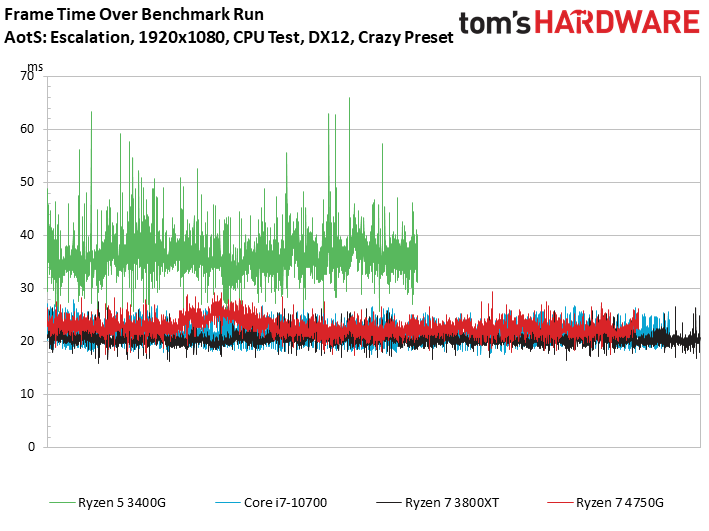

Ashes of the Singularity: Escalation loves cores and threads, but clock rates also play a role.
Dawn of War III on AMD Ryzen 7 Pro 4750G



The Warhammer 40,000 benchmark responds well to threading, but it's clear that clock speed and IPC also matter.
Far Cry 5 on AMD Ryzen 7 Pro 4750G

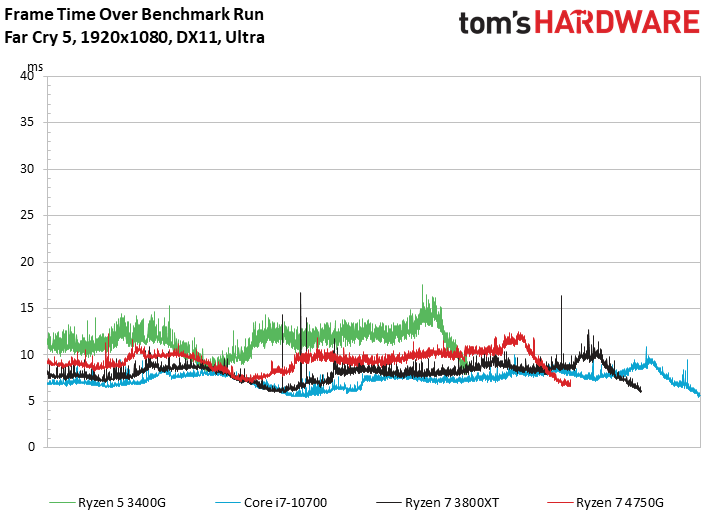

Final Fantasy XV on AMD Ryzen 7 Pro 4750G

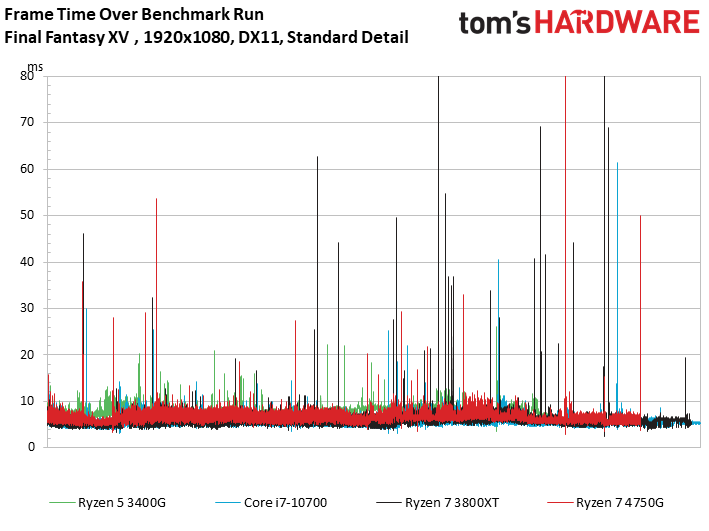
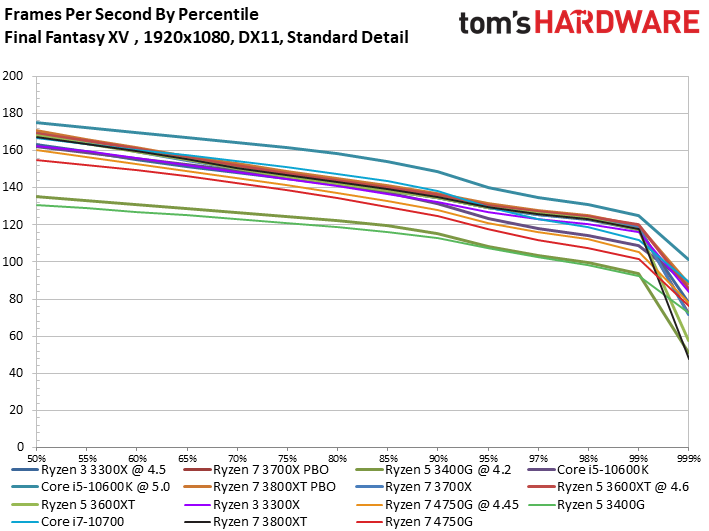
We run this test with the standard quality preset to sidestep the impact of a bug that causes the game engine to render off-screen objects with the higher-resolution setting.
Grand Theft Auto V on AMD Ryzen 7 Pro 4750G



Hitman 2 on AMD Ryzen 7 Pro 4750G



Project Cars 2 on AMD Ryzen 7 Pro 4750G
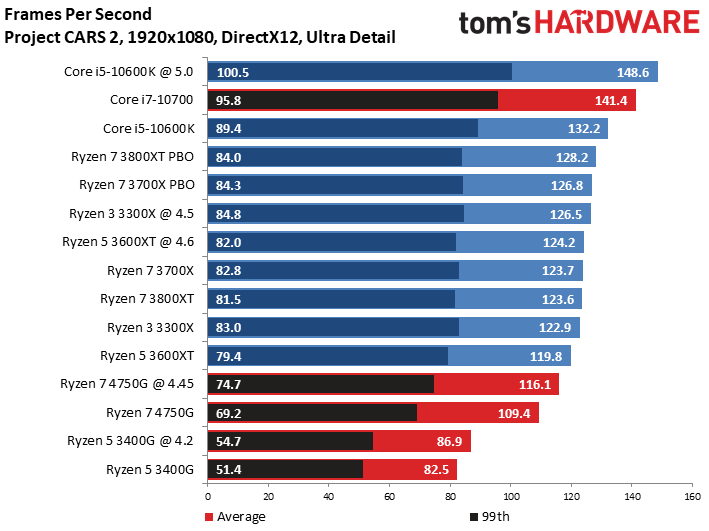


Although Project CARS 2 is purportedly optimized for threading, clock rates obviously affect this title's frame rates.
World of Tanks enCore on AMD Ryzen 7 Pro 4750G



MORE: Best CPUs
MORE: Intel and AMD Processor Benchmark Hierarchy
MORE: All CPUs Content
Current page: AMD Ryzen 7 Pro 4750G Discrete GPU Gaming Benchmarks
Prev Page AMD Ryzen 7 Pro 4750G Integrated Vega Graphics Gaming Benchmarks Next Page AMD Ryzen 7 Pro 4750G Application Benchmarks
Paul Alcorn is the Editor-in-Chief for Tom's Hardware US. He also writes news and reviews on CPUs, storage, and enterprise hardware.
-
mdd1963 I expected /hoped for a bit more than bumping FPS in games up only 10-15% compared to the 3400G.... (Apparently I will not be happy until they can match GTX1060-level of performance into the APU)Reply -
neojack impressive results ! this APU is more powerfull than my 2700x in raw power, AND has an igpu about equal to a gtx 1050Reply -
JarredWaltonGPU Reply
It's a bit weird, because the memory bandwidth is lower but all system RAM can be treated as shared VRAM, so you can sometimes run higher settings with less performance problems on in integrated Vega 8 GPU than on a dedicated GPU. But in general, Vega 8 for Renoir is roughly equal to an RX 560, which is basically equal to a GTX 1050.Gurg said:Curious as to which discrete GPU the iGPU is the equivalent.
In a lot of cases, the 1050 is still 25% faster, though. For example, Far Cry 5 1080p normal settings, I got 43 fps, Shadow of the Tomb Raider 1080p Medium I got 39 fps, and Strange Brigade 1080p medium I got 72 fps. That means the GTX 1050 beat the integrated 4750G's Vega 8 Graphics, even when the latter was overclocked. And the GTX 1050 is a pretty slow GPU by today's standards -- the GTX 1650 Super is over twice as fast as the GTX 1050. -
Gurg Reply
Thanks for the reply. It seems like a CPU/iGPU for a $1,000 laptop without a discrete GPU.JarredWaltonGPU said:It's a bit weird, because the memory bandwidth is lower but all system RAM can be treated as shared VRAM, so you can sometimes run higher settings with less performance problems on in integrated Vega 8 GPU than on a dedicated GPU. But in general, Vega 8 for Renoir is roughly equal to an RX 560, which is basically equal to a GTX 1050.
In a lot of cases, the 1050 is still 25% faster, though. For example, Far Cry 5 1080p normal settings, I got 43 fps, Shadow of the Tomb Raider 1080p Medium I got 39 fps, and Strange Brigade 1080p medium I got 72 fps. That means the GTX 1050 beat the integrated 4750G's Vega 8 Graphics, even when the latter was overclocked. And the GTX 1050 is a pretty slow GPU by today's standards -- the GTX 1650 Super is over twice as fast as the GTX 1050. -
Neilbob Replynofanneeded said:"Useless"
no 4th GEN PCIe means no one will buy it.
I agree. This is why Intel is unable to sell a single CPU! A computer without 4th GEN PCIe capability might as well be a brick, right?
(Sarcasm, just in case there's doubt) -
nofanneeded ReplyNeilbob said:I agree. This is why Intel is unable to sell a single CPU! A computer without 4th GEN PCIe capability might as well be a brick, right?
(Sarcasm, just in case there's doubt)
At least intel offers 16 lanes with their CPU . This chips only offers 8 lanes Gen3 .. useless. -
Neilbob Replynofanneeded said:At least intel offers 16 lanes with their CPU . This chips only offers 8 lanes Gen3 .. useless.
I would say 'limiting' rather than useless. Especially seeing as these APUs are intended for an OEM market that in all likelihood won't be pairing them with anything more than a mid-range GPU (that's what the Ryzen 3000 series is for).
Who's to say that more lanes won't be exposed if/when AMD release these for the DIY user base?
Of course, this is just pure speculation from me. Already got my 3600 so I'm all set either way (y)
Edit: So there actually are 16 lanes (which I missed in the review) so above posts turn out to be irrelevant.